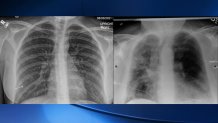A doctor examining side-by-side X-rays of lungs in vaccinated and unvaccinated COVID-19 patients said the images show the impact vaccines can make in preventing severe illness.
Dr. Tim Morris, a pulmonologist and ICU doctor at UC San Diego Medical Center, said it doesn’t take a trained eye to see the difference -- on the left are the lungs of a vaccinated COVID-19 patient and on the right is an unvaccinated COVID -19 patient.

The X-ray on the left shows more black space in the vaccinated patient’s lungs, which is normal and means the lungs are filled with air, according to Dr. Morris. The X-ray of the unvaccinated patient’s lungs shows more cloudy, white space, which means infection has started in the lungs.
Get San Diego local news, weather forecasts, sports and lifestyle stories to your inbox. Sign up for NBC San Diego newsletters.
“That's a sign of COVID pneumonia. This one looks very classic for the many, many X-rays that we have seen in COVID patients,” Dr. Morris said, adding that the clearer X-ray shows the vaccine at work.
Dr. Morris has been treating COVID-19 patients for the past year and a half and told NBC 7 he’s seeing more unvaccinated young people in his ICU in recent weeks as hospitals across the country see a surge in COVID-19 cases fueled by the delta variant.
The U.S. is now averaging more cases per day than last summer’s peak when no vaccines were available, and even though vaccination rates have increased recently, millions are still holding out on getting the shot.
Local
The CDC says less than 1% of vaccinated people get COVID-19.
Morris said the X-ray of the vaccinated patient -- post-vaccination COVID-19 contraction is extremely rare, according to Morris -- didn't show anything that would require hospitalization. Treatment for the unvaccinated patient on the other hand is not as promising.
“They would need to be given medications and high amounts of oxygen,” he said. “Some of those patients -- they would die because the infection was so overwhelming and their lungs were so markedly affected and so damaged that we wouldn't be unable to oxygenate them.”
Dr. Morris said it’s frustrating for him and his team to see unvaccinated patients deal with chronic post-recovery effects from a disease they could have prevented.
He said one lesson some of his unvaccinated COVID-19 patients are learning is that antibodies created after recovering from the virus are nowhere near as strong or reliable as the vaccine.
“People who have had the infection, who may already be harboring some damage to the lungs, nose, may be particularly vulnerable to a second infection,” he said. “The virus, when it gets down into the lungs, is very capable of causing long-term problems that may even include disabilities. But the person who had been vaccinated would very likely have recovered with no problems in their lungs at all, and they would lead entirely normal lives.”
Dr. Morris said this wave of the pandemic is different.
“We have seen plenty of people in their 20s who have gotten sick and by far, the overwhelming majority of people who have gotten sick and died from COVID have been unvaccinated,” he said. “It's been very heartbreaking to see that happen. We really thought that we were on the other side of this."
Dr. Morris told NBC 7 the key to ending the pandemic is to overcome vaccine skepticism, and that unvaccinated people need to understand the difference in consequences in going with the shot versus without.
“This is an urgent call to become vaccinated and protect yourself from getting sick and dying,” he said. “You don't need to get sick and die from COVID, we have the means to prevent that in a remarkably effective way.”
Dr. Morris said if vaccination rates don’t continue to rise, it’s only a matter of time before more variants emerge because they’ve had time to mutate, and they could potentially cause even more lung damage than the strains doctors have treated so far.
“It's part of our duty to try to reduce the spread of COVID so that we can reduce the chance of another mutation happening,” he said.
California is among dozens of U.S. states seeing a surge in COVID-19 hospitalizations as the highly contagious delta variant sweeps across the nation – this coming as millions still hold out on getting the vaccine.
Dr. Morris used a simple analogy to explain how helpful the vaccine can be in preventing major illness and hospitalization.
“An argument has been made that because there are cases of breakthrough infection that for some reason, the vaccine is ineffective or unhelpful,” he said. “There are people in traffic accidents who get hurt, despite the fact that they have seatbelts on. But there's no question that seatbelts are an effective way of saving lives, and that people are safer with seatbelts than without seatbelts. There is a means now to reduce the chance of getting sick and dying from COVID with vaccination, and if you can do it, you should do it.”



